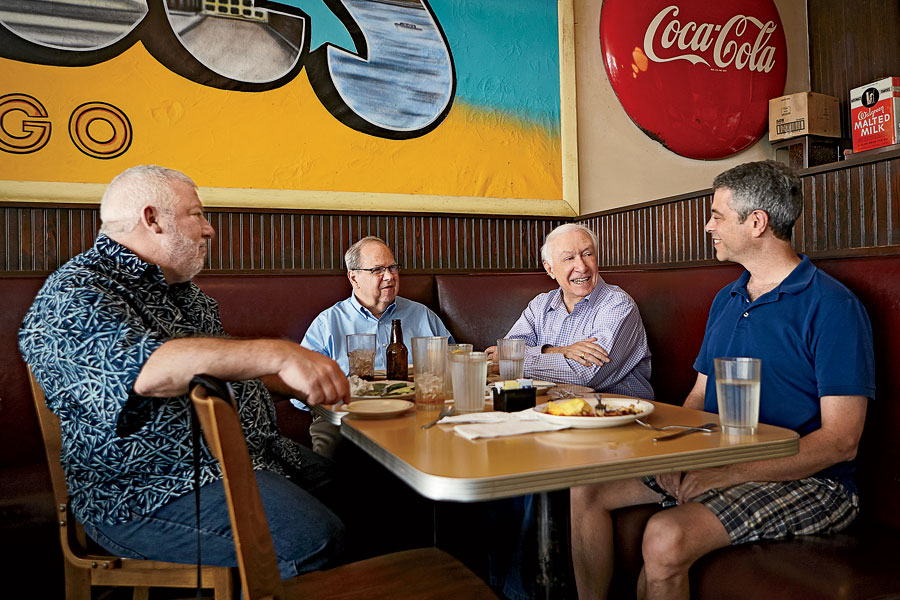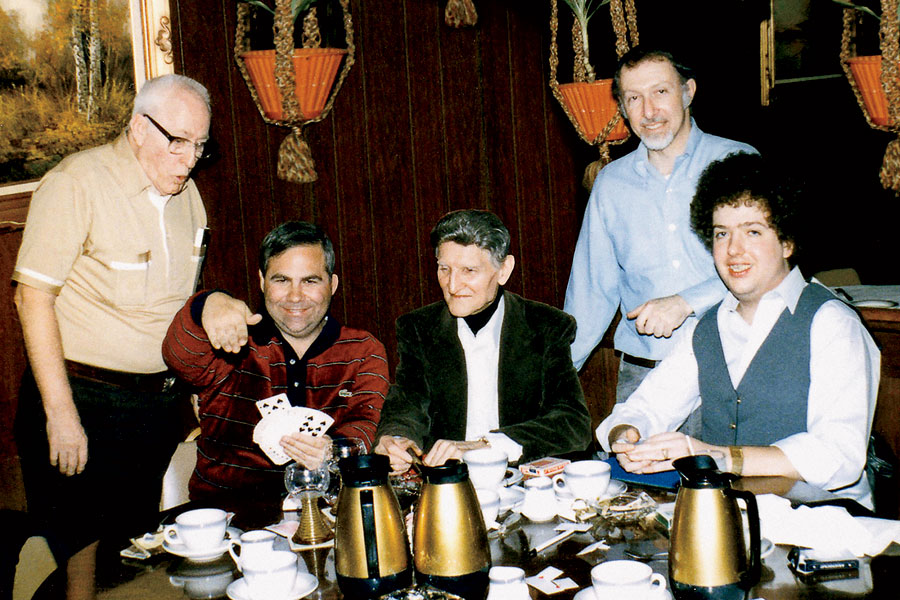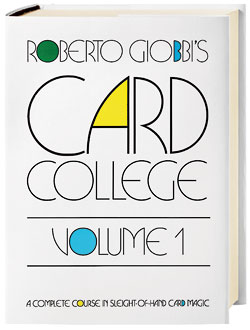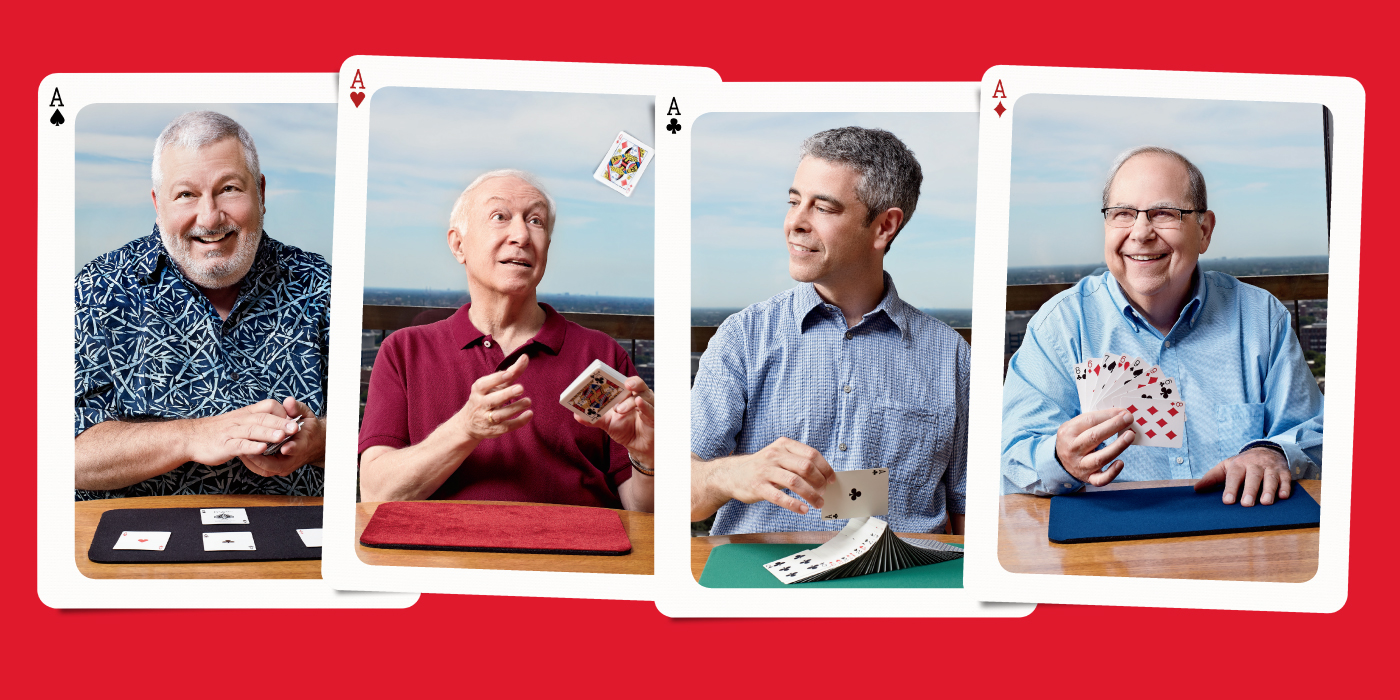John Bannon wants to show me a trick. He holds a full deck of cards in front of me at eye level and begins rapidly flicking them, one after the other, from his left hand to his right. They are facing out so I can see what they are but he can’t.
“Think of a card,” he says laconically as they blur past. Bannon is burly and suave, with a trimmed white beard. He exudes the relaxed, simpatico air of a seasoned bartender, with a touch of the huckster thrown in.
I see the ten of diamonds flash by and hold that card in my mind, keeping my eyes locked on Bannon’s movements, which reveal nothing untoward, and on the cards, which appear to belong to a completely normal deck.
When Bannon has transferred all the cards to his right hand, he turns them around, fans them out, and deliberates—or pretends to deliberate—for a dramatic beat or two, left hand hovering over them. Finally, he removes one from near the middle but doesn’t show it to me.
No way can it be my ten of diamonds.
Bannon is staring into my eyes. “What card are you thinking of?”
“Ten of diamonds,” I say.
He flips the card: the ten of diamonds.
How else to react but leap from my seat and tell Bannon to shut up, shut up, just shut up.
Countless similar miracles have graced the lacquered blond wood of this dining table on the 29th floor of a Lincoln Park high-rise. In fact, this table has arguably seen more playing cards riffle-shuffled, diagonal-palm-shifted, bluff-forced, block-transferred, in-jogged, and out-faroed than any surface in town.
Gathered around it at present, as on every Saturday, are Bannon and three other men, all nearing or past the far edge of middle age: David Solomon, David Finkelstein, and Simon Aronson, who is the owner of said table and the host of these weekly summits. Having duly impressed their visitor, the men get down to business, removing from their persons multiple packs of playing cards, like weapons for a gunfight, and stacking them neatly on black felt pads. Aronson prefers red-backed Bicycles from the United States Playing Card Company, which he purchases from Costco in 12-deck bricks. Bannon is a standard Bicycle man too. Solomon likes Bicycle Rider Backs that are “professionally cut”—that is, trimmed from the uncut sheet in such a way as to make a certain type of shuffle easier to perform. (You have to special-order those.) Finkelstein, the youngest of the group, has produced three decks today: Arrco Tahoe No. 84s, blue Bicycles, and Steamboat 999s, which are made of an especially smooth, thin card stock.

Next, hand lotion is applied—soft skin makes for better card handling. Aronson uses Cetaphil. Finkelstein prefers Neutrogena. Solomon favors Magician’s Choice Emerald Formula with aloe vera. Bannon does without.
The men ease into the session by fidgeting. When magicians fidget, it is invariably done with playing cards. They mindlessly shuffle, fan, cut—a perpetual fussing, an ideomotor tic. When their hands aren’t in motion, they tend to hold the deck in the “mechanic’s grip”: resting in the palm of the left hand, thumb at the top left corner, index finger across the top edge, middle and ring fingers curled around the right edge, pinkie resting slightly above the bottom right corner. This is the ready position.
Solomon, a gentle-mannered army vet with a predilection for classic tricks, starts things off with an old one he’s been refining for 40 years. It’s called “Oil and Water.”
He spreads out eight cards face-up—four blue-backed ones with black suits and four red-backed ones with red suits—alternating the colors: black-red, black-red, black-red, black-red.
He then gathers the cards into a neat pile, picks them up, and offers a short spiel. “With oil-and-vinegar salad dressing,” he says, “if you shake it up and let it settle, eventually the oil comes to the top. It’s impossible to make them mix because it goes against chemistry.”
He gives the cards a shake and fans them out face-up again. The black and red suits have miraculously separated.
No way. I ask him to do the trick again.
He re-sorts the cards, alternating them by color as before—clear as day, no visible funny business—and gathers them into a pile again. He gives them another shake and fans them out once more. The colors have separated.
Now, I’m pretty good at sussing out card tricks—and know quite a few good ones myself—but I could detect no sleight of hand, no moment when I thought, Aha, he just did something there. It just happened … magically.
Among devotees of card magic—myself included—Bannon, Solomon, and Aronson are demigods. (Finkelstein, relatively new to the group, hopes to be one eventually.) These men are to the world of card tricks what Diane Warren and Kenneth “Babyface” Edmonds are to pop music—they compose hits. Here’s a fun experiment: Fly to Japan or Sweden and ask any halfway proficient magician there to show you Bannon’s trick “Play It Straight Triumph.” Chances are, that magician will break out a step-for-step rendition the way a pianist might play “Heart and Soul.” Bannon, Solomon, and Aronson have, among them, published 14 books about professional card magic—expensive hardcovers that would make as much sense to curious neophytes as tomes on metallurgical engineering.
Here’s the thing about card magic: Most tricks don’t get passed down from master to protégé in smoky backrooms or shared through some underground society with secret handshakes. Card magicians learn their tricks from books. The amount of literature devoted to professional-level card magic is staggering. Midwest Magic in Franklin Park is one of the largest magic shops in the world and carries some 1,200 titles on the craft. The vast majority of those books can’t be found on Amazon.com or at a Barnes & Noble. Most aren’t even registered with the Library of Congress. These are not publications in search of a wide audience. The methodologies they contain are tantamount to state secrets. Some magicians are so protective that if they are at a store and happen upon a beginner’s book containing tricks they deem too advanced, they will reshelve the volume in the remotest possible corner of the store.
Among the thousands of books on card magic, those by Solomon, Bannon, and Aronson are considered essential reading.
The famed sleight-of-hand artist Ricky Jay, who hung out with Aronson and Solomon in the 1970s, has nothing but praise for them—or at least what passes for praise coming from Jay, who is famously antisocial with other magicians. “I respect the work of Simon and David,” he tells me, “and as far as I know, their work is absolutely respected in the world of card magic. And I’m happy to say this.”
Tim Felix, the owner of Midwest Magic, is less circumspect. “Any book that Simon, David, or John puts out absolutely has had an impact on the market,” he says. “These are tricks people all around the world perform. Their reputation precedes them.”
This is fact. When I was growing up, Bannon, Solomon, and Aronson were Griffey, Kirby, and Ozzie to me. I would save up my allowance to buy their books. My first job in high school was at a magic shop in Seattle’s Pike Place Market that stocked tricks invented by these three, and I would demonstrate the tricks and sell them to fellow magicians. (I made these guys money before I learned how to drive.)
What attracted me to magic? I love the intellectual challenge the tricks pose. I love how something that looks utterly impossible can have a linear, clear-cut explanation.
For me, getting to witness the Saturday afternoon sessions that are whispered about at magic shops is—to paraphrase Finkelstein, who long regarded Aronson and the rest with similar awe—like being asked to pick up a guitar and sit in with the Rolling Stones.
One thing I notice at the first Saturday gathering is how swank Aronson’s apartment is: million-dollar view, elegant vase collection, original masterworks on the walls, including a Dalí print depicting playing cards. Aronson, who is 72, had a lucrative day job as a real estate attorney before retiring 17 years ago to devote himself to card magic. Solomon, also 72, is a retired business-forms distributor. The other two men still have demanding and successful careers: Bannon, 58, is a commercial business litigator; Finkelstein, 54, is a University of Chicago philosophy professor who teaches a course titled Wonder, Magic, and Skepticism.
While there are tens of thousands of card tricks out there, virtually all of them fall into half a dozen or so well-known categories—those involving divination, say, or “animation” (cards moving with no visible cause)—and almost all require sleights, the deft and wickedly difficult physical maneuvers required to execute card magic. These men have been doing card tricks for so long that they’ve got the sleights committed to muscle memory, and they’ve mastered tricks across the spectrum of categories. So the finer points of methodology are what get workshopped most at the Saturday sessions. As does presentation. Do the rhythm and cadences in the delivered lines feel right? Is there fat that could be trimmed?
After Solomon’s “Oil and Water,” Finkelstein volunteers a work in progress, putting himself out there for critique or approval.
He addresses Bannon: “I’m going to turn my back, John. Take a card from the middle of the pack, put it in your pocket.”
Bannon does so and hands the deck back to Finkelstein.
Finkelstein launches into the routine: “The magician’s deck of cards is like a violin. In the hands of a maestro, it’s a musical instrument. But I’m very literal minded, so I’m just listening to this.”
He theatrically leans down, ear first, and taps the deck against the table.
“Sounds like a spade … a king. … No! The seven of spades.”
Bannon pulls the seven of spades from his pocket.
Finkelstein looks pleased. The others look indifferent.

Magicians at this level rarely get swept up with amazement. The more knowledgeable you are about methods, the less you experience those moments of childlike wonder. After a time, it’s less about artifice (“Wow! How did you do that?”) and more about nuts and bolts (“I like that variation of the spread half-pass”).
And with close-up card magic, in which the proximity of the spectator makes deception harder, the nuts and bolts are everything. On the tiny felt-topped stage, careful hand positioning is essential. To wit: One way of hiding a sleight of hand is to have a more overt move happen simultaneously. For example, the moment you reach across the table for the card box with your left hand is an ideal time to switch out one card for another with your right hand.
That is just one of many kinds of misdirection: making the audience look here instead of there. As often as not, misdirection is more psychological than physical. The magician might ask a question midtrick—“You have chosen this card of your own free will, have you not?”—causing the spectator to look up and make eye contact, providing a few instants of cover to execute a secret maneuver.
Punch lines work, too. Aronson tells me, “Asking a question is directing eye contact. But whenever a person laughs, it’s getting a person to relax and lose attention.”
Magicians are also constantly seeking ways to improve their showmanship. Bannon, for example, is a fan of kicker surprises: Just when you think the trick is over, bam! A twist. One of my favorite tricks of Bannon’s is where a spectator picks a card—say, the eight of spades—and Bannon divines the selection as follows: “It’s a black card … it’s a high card … it’s an eight! A black eight!” And just as the individual is marveling at that, Bannon opens the empty card box and dumps out a billiard eight ball.
Later that afternoon, after a few more tricks are workshopped, the conversation around the table grows philosophical. Aronson says he believes tricks should “create the illusion of impossibility.” When all the components of a magic trick come together, he contends, it should produce a dissonance—a state in which one half of the brain knows what it witnessed isn’t possible while the other half of the brain goes, “But wait, I just saw it.” Aronson has a line in one of his books that has been frequently quoted by magicians: “There is a world of difference between a spectator’s not knowing how something is done versus his knowing that it can’t be done.” This instant of pleasurable confusion is known as—to borrow a term popularized by the magician Paul Harris—the moment of astonishment.
Bannon is of a different opinion. “I believe when people are watching magicians, they are aware that they’re being deceived. I don’t think they ever let go of that.”
In other words, tricks are a playful con job, and magicians should let spectators know early on that they’ll be taken for a ride.
“I believe in cognitive dissonance,” Bannon adds, “but cognitive dissonance never resolves in favor of magic. I don’t believe for a second that people don’t try to figure it out.”
Bannon and Aronson don’t try to convince each other that they’re right. Their respective philosophies on magic are ossified and unyielding, opinions shaped over many decades.
The importance of Chicago in the world of card magic can’t be overstated. It was here, more than a century ago, that the book many card magicians regard as their bible was published—a volume to which Aronson, Bannon, Solomon, and countless others can trace their lineage. Artifice, Ruse and Subterfuge at the Card Table: A Treatise on the Science and Art of Manipulating Cards—later published under the more manageable title The Expert at the Card Table—is essentially a two-part guide. The first half reveals techniques on how to cheat at cards, employing fake shuffles or dealing from the bottom of the deck. The second half is geared toward magicians, with step-by-step illustrated instructions for now-classic tricks. Ricky Jay borrows verbatim from this publication, with all its delightful turn-of-the-century locutions, for his stage patter.
“It’s extraordinarily important,” Jay says of the book. “Because it’s both really well written and absolutely innovative in terms of what it tried to teach and make people aware of. It’s not wrong to say it’s the seminal book of card magic.”
The author, who published under the nom de plume S.W. Erdnase, was most likely a card hustler named Milton Franklin Andrews, who had moved to Chicago from Hartford, Connecticut, as a young man. Andrews reportedly had a violent streak and a fondness for prostitutes; he was the prime suspect in the unsolved murder of one of his lady companions.
Today, first editions of The Expert at the Card Table fetch upward of $10,000 at auction. Much to the chagrin of many magicians, a widely distributed paperback version can now be purchased for under $10.
By the middle of the 20th century, Chicago had become the epicenter for magic performed seated at a table—a subgenre known as close-up magic. Beginning in the 1930s, several dozen magicians would meet daily at a downtown restaurant called Drake’s, where they would have lunch, talk shop, maybe learn a trick or two. The sessions became known as the Chicago Magicians’ Roundtable. Many of those in attendance, characters like Matt Schulien and Jim Ryan, owned their own drinking establishments. By night, they were the city’s most popular practitioners of bar magic—another subgenre born in Chicago. At places like the New York Lounge in Lincoln Square and Johnny Paul’s Magic Lounge in Cicero, the bar counter would become the stage for card magic performed for a beer-swilling audience.
Magic shops flourished in Chicago during the postwar years. At one point, there were more than half a dozen in the Loop alone. There was even a filmed-in-Chicago TV show about magic. It was called Magic and ran on ABC in the early 1950s. The host, Don Alan, is regarded as a pioneer of televised close-up magic.
One of the most famous names to emerge from the Chicago close-up magic scene after World War II is that of Ed Marlo. Born in 1913 and raised in Humboldt Park, Marlo worked at a tool and die factory for most of his life, but his obsession (and perhaps that is too light of a term) was card magic—he never left home without a deck and even kept one under his pillow. Marlo published more than 4,000 tricks and sleight-of-hand techniques in his lifetime, many appearing in his self-published Marlo’s Magazine, others in booklets that were sold at Magic Inc., a shop in Lincoln Square.
Marlo lunched in Lincoln Square every Saturday at the Three Bears (now gone) and later at the Palladium (also gone). Protégés would crowd around his table, cards in hand. The Marlo Table, as these gatherings came to be known, was a more serious affair than the Magicians’ Roundtable. Students would show off their latest tricks and moves, trying to fool one another, but mostly they were there to watch Marlo. Anytime a nonmagician wandered to that corner of the restaurant, cards would disappear beneath the table and the encroacher would be told he wasn’t welcome.
In 1965, David Solomon and Simon Aronson, both college age at the time, met by chance at Magic Inc. and became mainstays at the Marlo Table. Soon the two men were getting together to play chess and test out their latest card tricks. They became close friends. Aronson, a New York transplant, was a regular at the Solomon family’s South Shore home. When Aronson got married, Solomon was his best man.
The two kept attending Marlo’s Saturday luncheons all the while. In 1991, a young law student named John Bannon visited Marlo’s Table. Solomon and Aronson liked the novelty of Bannon’s magic—he used coins, tweezers, billiard balls, and Swiss army knives in his tricks. After Marlo died that year, Solomon and Aronson decided to continue the Saturday tradition on their own and invited Bannon to join them. They decided to meet in Aronson’s apartment because it had the best view. By then, the three magicians were more than hobbyists—they had gained a following for their lectures and published material. Aronson and Solomon had collaborated on a book called Sessions, now a sought-after collectible on eBay.
In 2009, the trio became a quartet. By his own account, David Finkelstein, who caught the magic bug as a child and already owned many books by Solomon, Aronson, and Bannon, bribed his way into the circle with a box of doughnuts.
Card Magic: Getting Started
Buy the right cards and a magic pad. Bicycle is the card brand of choice of most magicians. Be sure to get ones with a white border on the back—essential for certain kinds of tricks. A felt-topped “close-up” pad makes card handling easier and lends performances a professional air.
Stream Deceptive Practice (Netflix). This fascinating documentary on sleight-of-hand artist Ricky Jay is a moody entrée into the world of card magic.
Visit a real magic shop. There aren’t many brick-and-mortar ones left, but the Chicago area still boasts four, all well stocked with books, videos, cards, tricks, and accessories and staffed by aficionados who will almost always perform a free magic show on request: Magic Inc. and Ash’s Magic Shop in Lincoln Square, Midwest Magic in Franklin Park, and PJ’s Trick Shop in Arlington Heights.

Read Roberto Giobbi’s Card College (amazon.com). This five-book series from Hermetic Press is the clearest, most nonboring guide to card magic, ushering you from rudimentary sleights of hand to professional-caliber amazements. For beginners, the first two volumes will provide a solid foundation.
Watch Easy to Master Card Miracles, volumes 1 to 3 (available at the aforementioned shops). The first three DVDs from this nine-volume series by magic instructor Michael Ammar are a greatest-hits compilation of classic tricks. —K.P.
The Saturday tradition at Aronson’s apartment passed the quarter-century mark this year. Aronson and Solomon’s friendship is 25 years older than that. On occasion, the interactions of the men resemble an old married couple’s.
Bannon lets me choose a card.
I pick the four of hearts.
Bannon deals a card for every letter in that phrase: F-O-U-R-O-F-H-E-A-R-T-S.
When he gets to the S, he turns over the four of hearts.
Bingo.
Aronson isn’t impressed.
“I’m not sure I liked the overall effect,” he says.
An argument ensues—they’re using their outside voices now—and Aronson’s wife, Ginny, peeks in from the kitchen to see what the fuss is about. The men stray deep into technicalities.
Finally, Aronson offers a tweak—and here I must be coy, for one of the conditions of my sitting in on their think tank was that I wouldn’t reveal any methods. What I can say is that the tweak has to do with a combination of mathematical probability, linguistic subterfuge, and a sleight-of-hand maneuver disguised as a normal human gesture. Combined, these adjustments will make the trick all but impregnable, according to Aronson.
Bannon, arms crossed, ponders for several beats. “That’s actually a good idea,” he says at last.
Aronson: “Of course it is!”
The session wraps up with one more moment of astonishment, one more dose of cognitive dissonance, this one from the mind of Finkelstein.
His spiel goes like this: “There’s a lot of magic tricks where the magical effect is a coincidence, but a coincidence isn’t always particularly magical. For example, if we were to each take a deck of cards and started dealing it face-up one at a time, if at some point we dealt the same card, it’d be a coincidence, but it wouldn’t be magical.”
Finkelstein unpacks two decks of cards and hands one to me. “On the other hand,” he continues, “if you were to name a random card and we took two decks of cards and we did the same thing and the matching card was the very same card you named, well, that would be a freakin’ miracle.”
He asks me to name a card.
I choose the two of diamonds.
We both start dealing through our decks, one card at a time, with Finkelstein following my lead. He turns over his cards calmly and without any visible chicanery.
Roughly halfway through my deck, I turn over the two of diamonds. Finkelstein flips his next card: the two of diamonds.
A freakin’ miracle.



